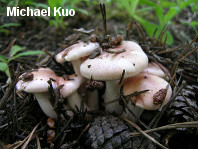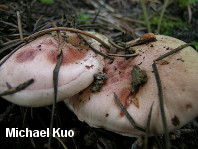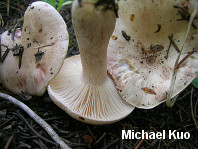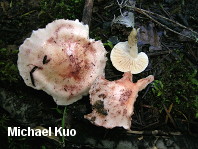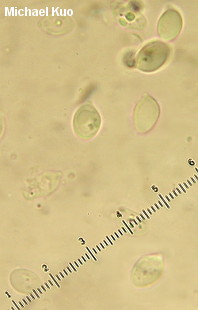| Major Groups > Gilled Mushrooms > Pale-Spored > Waxy Caps > Hygrophorus erubescens |

|
Hygrophorus erubescens [ Basidiomycota > Agaricales > Hygrophoraceae > Hygrophorus . . . ] by Michael Kuo This variable species of Hygrophorus is one of several that develop pink to reddish spots and discolorations on the gills. Although its cap color varies from nearly white to pink to fairly dark red, Hygrophorus erubescens can be identified by its fairly small size, nearly distant gills, preference for conifers, the fact that it lacks a partial veil when young, and its spores, which measure 8-10 µ long. Similar mushrooms include Hygrophorus russula (usually larger, found under oaks and other hardwoods, spores 5-8.5 µ long), Hygrophorus purpurascens (usually larger, with a partial veil when young, spores 5.5-8 µ long), and Hygrophorus capreloarius (cap and gills darker and more evenly colored, spores 6.5-8 µ long). Hesler & Smith (1963) described Hygrophorus erubescens var. gracilis as a slender, long-stemmed variety. Description: Ecology: Mycorrhizal with conifers; growing scattered or gregariously; late summer and fall, or over winter in warmer climates; apparently widely distributed in North America, but much more common from the Rocky Mountains westward. The illustrated and described collections are from Colorado and California. Cap: 2-8 cm; convex when young, becoming broadly convex or flat; sticky when fresh, but often drying out quickly; bald, or finely hairy in places; the margin at first inrolled, but eventually unrolling; whitish to pink (especially over the center), often with streaks or spots of color. Gills: Broadly attached to the stem or beginning to run down it; nearly distant; whitish to pale yellowish; developing reddish spots or becoming pinkish overall; short-gills frequent. Stem: 3-10 cm long; 0.5-1 cm thick; more or less equal, or tapering to base, or (when young) nearly club-shaped; whitish at first but often developing pinkish to reddish discolorations; sometimes bruising yellowish in places; bald or finely hairy; solid. Flesh: White; firm; unchanging when sliced, or changing slowly yellowish. Odor and Taste: Not distinctive. Spore Print: White. Microscopic Features: Spores 8-10 x 5-6.5 µ; smooth; ellipsoid, often with one side somewhat flattened near the apiculus; smooth; hyaline in KOH; inamyloid. Hymenial cystidia absent. Basidia 4-sterigmate; to about 50 µ long. Lamellar trama divergent. Pileipellis an ixotrichoderm. REFERENCES: (Fries, 1821) Fries, 1838. (Saccardo, 1887; Hesler & Smith, 1963; Bird & Grund, 1979; Smith, Smith & Weber, 1979; Largent, 1985; States, 1990; Phillips, 1991/2005; Evenson, 1997; Barron, 1999; Trudell & Ammirati, 2009; Lodge et al., 2013.) Herb. Kuo 01151103. Herb. DBG RMNP 2008-035, 2008-036. This website contains no information about the edibility or toxicity of mushrooms. |
© MushroomExpert.Com |
|
Cite this page as: Kuo, M. (2014, July). Hygrophorus erubescens. Retrieved from the MushroomExpert.Com Web site: http://www.mushroomexpert.com/hygrophorus_erubescens.html |
